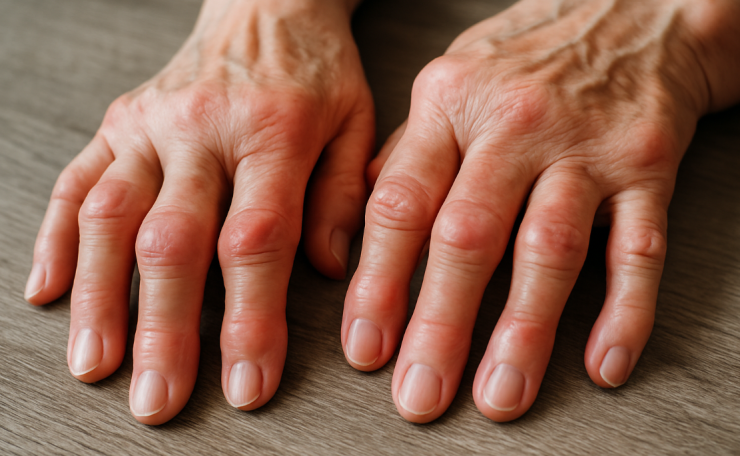Understanding Rheumatoid Arthritis
Rheumatoid arthritis (RA) is a chronic autoimmune disease where the body’s immune system mistakenly attacks healthy joint tissue. This triggers inflammation that leads to joint pain, swelling, and stiffness—typically affecting both sides of the body, like both hands or knees, making RA different from other types of arthritis.
Over time, RA doesn’t just target joints—it can impact organs such as the heart, lungs, and even the eyes, highlighting the importance of early diagnosis and management.
Juvenile Rheumatoid Arthritis (JIA)
When RA occurs in children under 16, it’s known as juvenile idiopathic arthritis (JIA). The symptoms include persistent joint stiffness and swelling lasting over six weeks. While some children outgrow JIA, others may experience long-term effects on bone growth and mobility.
Common Types of JIA:
- Oligoarthritis: Affects four or fewer large joints.
- Polyarthritis: Impacts five or more joints.
- Systemic JIA: Involves internal organs, accompanied by high fever and rash.
- Psoriatic Arthritis: Combines joint pain with a scaly rash.
- Enthesitis-Related Arthritis: Targets areas where tendons and ligaments attach to bones.
- Undifferentiated Arthritis: Symptoms don’t fit into a specific category.
Signs and Symptoms of RA
Symptoms vary from person to person, but common warning signs include:
- Persistent joint pain and swelling
- Morning stiffness lasting over an hour
- Fatigue and low-grade fever
- Nodules or rashes on the skin
- Difficulty with basic movements
RA may progress gradually or emerge suddenly. Some individuals experience flares, while others go into remission.
Risk Factors and Causes
Anyone can develop RA, but several factors can increase your risk:
- Gender: Women are 2–3 times more likely to develop RA.
- Age: Commonly begins in middle age.
- Family history
- Smoking
- Obesity
Though the exact cause remains unclear, scientists believe genetic susceptibility combined with environmental triggers like infections may initiate the autoimmune response.
Impact on the Body
RA starts in the synovium—the tissue lining the joints. Inflammation here can destroy cartilage and bone over time. Eventually, this damage can cause deformities, mobility issues, and affect other systems such as:
- Hands: Stiffness, nodules, difficulty gripping
- Feet: Arch collapse, bunions, difficulty walking
- Neck: Stiffness, restricted motion
- Heart and Lungs: Inflammation, pericarditis, nodules, pleurisy
- Skin and Eyes: Rashes, dry eyes, inflammation
RA Progression: The 4 Stages
- Stage 1: Joint inflammation without visible damage
- Stage 2: Cartilage damage begins, limited mobility
- Stage 3: Bone erosion and joint deformity
- Stage 4: Loss of joint function, potential disability
Complications Beyond the Joints
RA increases the risk of:
- Cardiovascular disease
- Osteoporosis
- Anemia and blood disorders
- Lung diseases
- Eye complications
- Infections
- Mental health issues such as depression
Diagnosing Rheumatoid Arthritis
There is no single test for RA. Diagnosis typically involves:
- Physical exam and symptom history
- Blood tests (CRP, ESR, RF, anti-CCP)
- Imaging (X-rays, ultrasound, MRI)
Doctors look for inflammation in multiple joints, symmetry, and biomarkers.
Treatment Options for Rheumatoid Arthritis
Medications:
- Pain Relievers: Acetaminophen, topical creams
- NSAIDs: Ibuprofen, naproxen
- Corticosteroids: Prednisone to reduce inflammation
- DMARDs (Disease-Modifying Anti-Rheumatic Drugs): Methotrexate, sulfasalazine
- Biologics & Biosimilars: Abatacept, adalimumab, infliximab
- Targeted Synthetic DMARDs: Tofacitinib, upadacitinib
When Is Surgery Needed?
In cases of severe joint damage, procedures such as joint replacement or synovectomy may be considered.
Complementary Therapies and Home Remedies
- Fish oil & plant oils: May reduce stiffness (consult your doctor first)
- Tai Chi: Low-impact movement for joint flexibility
- Heat & Ice Therapy: Reduce pain and inflammation
- Relaxation & Sleep Hygiene: Manage stress and fatigue
- Ayurveda: Some find relief, but caution is advised due to metal content in some treatments
Lifestyle and Diet Changes
A balanced, anti-inflammatory diet can help reduce flare-ups:
- Prioritize healthy fats (omega-3s)
- Avoid processed foods and excess sugar
- Follow a heart-healthy or Mediterranean-style diet
- Stay active with low-impact exercises like swimming or walking
Living Well With RA
Though there’s no cure for rheumatoid arthritis, early diagnosis and consistent treatment can make a world of difference. Combining medical treatment with healthy habits empowers patients to live a full, active life.
Frequently Asked Questions
Can RA be cured?
No cure exists, but many go into remission with proper care.
When is exercise safe?
Outside of flare-ups, low-impact exercises improve joint flexibility and overall health.
Is surgery always required?
Not always. It’s typically reserved for cases with advanced joint damage.
Sources
- Mayo Clinic – Rheumatoid Arthritis
- American College of Rheumatology – RA Overview
- NIAMS (National Institute of Arthritis and Musculoskeletal and Skin Diseases)
- WebMD – Rheumatoid Arthritis
- NIH – Rheumatoid Arthritis Overview
Disclaimer: This article is intended for informational purposes only and should not be considered medical advice. Always consult with a qualified healthcare professional before starting or changing any treatment plan related to rheumatoid arthritis or any other health condition.




